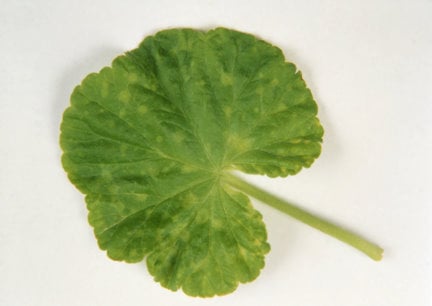
Quick facts
Common name - Pelargonium viruses
Scientific name - Various
Plants affected - Pelargonium (geranium)
Main causes - Virus
What are pelargonium viruses?
Over 20 different viruses have been found infecting Pelargonium; these viruses cause a wide range of symptoms. Virus symptoms in pelargoniums are sometimes masked in warmer temperatures and often develop only in winter and spring.
Viruses known to infect pelargoniums include:
Pelargonium flower break virus
Pelargonium line pattern virus
Arabis mosaic virus
Beet curly top virus
Cucumber mosaic virus
Impatiens necrotic spot virus
Tomato bushy stunt virus
Tomato ringspot virus
Tomato spotted wilt virus
Tobacco mosaic virus
Tobacco necrosis virus
Tobacco rattle virus
Symptoms
Virus-infected plants may show one or more of the following symptoms;
- White streaks in the flowers, known as 'breaks'
- Yellow mosaic or mottling patterns on the leaves
- Sometimes leaves develop line patterns, or ringspots, or the leaves may be deformed
- Stem and leaf necrosis (browning due to tissue death)
- Plants may be stunted, with a general lack of vigour
Control
Non-chemical control
- If infection is suspected the plant should be destroyed – there are no cures for plant virus infection
- Old cultivars are more likely to be infected
- It is unlikely that amateur gardeners will encounter Tomato ringspot virus, but pelargonium enthusiasts and commercial specialists should be aware of its symptoms and its quarantine status. Details can be found on the UK Plant Health Risk Register
Chemical control
There are no chemical controls for plant virus infection.
Biology
Plant viruses are extremely minute infectious particles consisting of a protein coat and a core of nucleic acid. They have no means of self-dispersal, but rely on various vectors (including humans) to transmit them from infected to healthy plants. Once viruses penetrate into the plant cells they take over the cells’ nucleic acid and protein synthesis systems and ‘hijack’ them to produce more virus.
Viruses are frequently transmitted through propagated material but, depending on the virus, can also be transmitted via insect or mite vectors, pollen, mechanical transfer via contaminated hands and tools, and nematode vectors in the soil. Some viruses can be transmitted via seed, but generally these are a minority and therefore seed propagation is often a useful way to ensure virus-free plant material.
Viruses of pelagoniums can all be transmitted to the next generation of plants through taken from infected plants. The viruses can also be transmitted by various vectors, as follows:
Beet curly top virus - leaf hoppers
Cucumber mosaic virus - aphids
Impatiens necrotic spot virus and Tomato spotted wilt virus - thrips
Arabis mosaic virus, Tobacco necrosis virus, Tobacco rattle virus, Tomato bushy stunt virus, and Tomato ringspot virus - nematodes
Pelargonium flower break virus, Pelargonium line pattern virus, Tobacco mosaic virus and some of the other viruses mentioned above, can be easily transmitted mechanically on pruning tools and on hands.
These viruses are unlikely to be of importance to most gardeners, because commercial suppliers of plants will normally have taken steps to ensure that their stocks are virus-free. However, gardeners with pelargonium collections are more likely to encounter problems. Viruses are typically much more of a problem when plants are multiplied over many years by vegetative means (cuttings), because infections slowly increase in stock material over the years. Many viruses are not seed borne, so new cultivars produced by hybridisation, and plants normally propagated by seed, are less affected.

